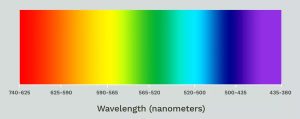This reduces the chance of mistakenly keying out skin tones during post-production.However, avoid green clothing or props to prevent removing them along with the background.
Types of Chroma: What You Need to Know
Types of Chroma : Keying is a crucial technique in VFX (Visual Effects). It involves removing a coloured background (usually green or blue) and replacing it with another image or video. Understanding the wavelengths of chroma colours is crucial in explaining why green and blue are frequently used. Let’s break it all down.

1. Types Of Chroma : Green Screen

The green screen is the most common chroma colour in VFX. VFX supervisors choose green because it is the brightest color in the RGB color mode. It has a wavelength of about 520 nm. This makes it easier for digital cameras to capture clean, high-contrast footage. Green is highly reflective, which means it can be lit evenly with less effort. Since the human eye is also sensitive to green, the camera captures it clearly, making it ideal for chroma keying.
Green also contrasts well with human skin tones, which primarily contain red and yellow wavelengths.
2. Types Of Chroma : Blue Screen

The VFX industry also commonly uses the blue screen as a chroma key. Blue has a wavelength of about 450 nm, which is shorter than green. But still far enough from the human skin’s red and yellow tones. Blue screens are especially useful in low-light conditions, as they reflect less light than green. Scenes with green elements (like clothing or props), blue becomes a more suitable choice because it doesn’t interfere with the subject.
However, just like with green, the subject must avoid wearing blue, as any blue part of the scene could be mistakenly keyed out.
3. Virtual/Hybrid Chroma (LED Walls)
In virtual production, LED walls display realistic backgrounds in real time, eliminating the need for traditional chroma screens. LED walls project 3D environments that surround the set, giving the actors a more immersive experience. While this doesn’t directly involve chroma colors like green or blue, the concept still uses the principles of color contrast to enhance the scene’s realism.
By using real-time lighting and matching the background environment to the foreground elements, virtual production offers a new way to create effects without relying on traditional chroma keying techniques.
4. Types Of Chroma : Other Colors (Red, Yellow, etc.)
Although green and blue are the most common for chroma keying, other colors can be used in specific situations. Red has a wavelength of around 650 nm, which is the longest in the visible spectrum. Professionals generally avoid it for chroma keying because it can interfere with human skin tones, especially in areas like the face where reds and browns are present. VFX artists sometimes use yellow (with a wavelength of about 570 nm), but it also presents challenges due to its overlap with certain skin tones
5. Luma Keying (Black/White Backgrounds)

Luma keying is a technique that uses brightness levels rather than color to separate elements. This method is especially useful for extracting effects like smoke or fire. It doesn’t rely on chroma colors but instead uses black-and-white backgrounds. By keying out lighter (white) or darker (black) areas, luma keying creates transparency for parts of the image that are semi-transparent or irregular, like wisps of smoke or particles.
Wavelengths and Chroma Keying
In chroma keying, the color’s wavelength is essential. Digital cameras use the RGB model (Red, Green, Blue), and each colour’s distinct wavelength influences how the camera captures it. For example:
- Green has a wavelength of around 520 nm.
- Blue has a wavelength of around 450 nm.
- Red has a wavelength of around 650 nm.
VFX professionals select these wavelengths because they stay far from human skin tones, which contain more red and yellow. This contrast makes it easier for software to isolate and remove the chroma background without affecting the subject.
Why Wavelength Matters in VFX
Professionals choose the wavelengths of chroma colours (green and blue) for their strong contrast with human skin tones and their ability to be captured cleanly by digital cameras. By using green or blue, VFX artists can ensure that the subject is separated from the background without interference from skin colours. This approach increases the precision of the keying process by removing the background while keeping the subject intact.
Conclusion
In VFX, the types of chroma used—green and blue—are chosen for their distinct wavelengths and their ability to contrast with human skin tones. Green (around 520 nm) is the most commonly used due to its brightness and the way it interacts with digital cameras. Blue (around 450 nm) is used when the scene involves green elements or requires low-light conditions. Understanding wavelengths helps create cleaner, more precise keying, making it easier to replace backgrounds and integrate CGI and special effects into a scene.

